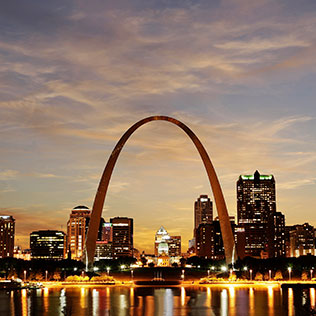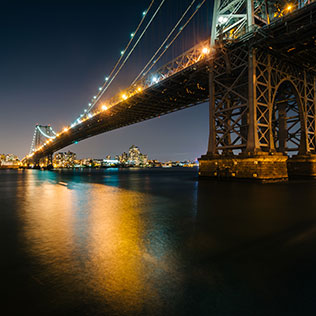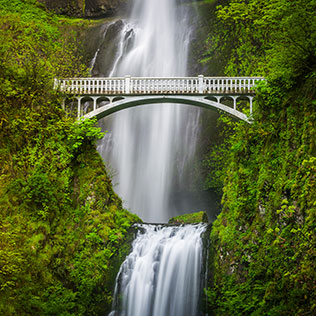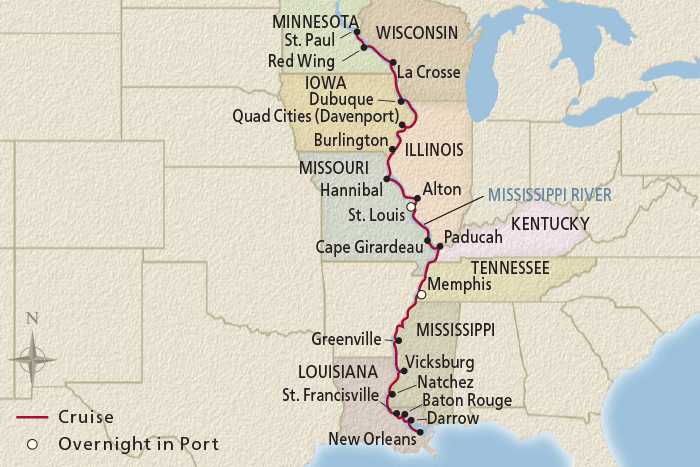Find the River Cruise you’re looking for...
22 Day Viking River Cruise from New Orleans to St. Paul 2026

Mississippi River Odyssey
River Cruise Description
Revel in the charm of “America’s Great River” as you set sail along the Mississippi. Admire the historic mansions and grand homes atop its bluffs, and delve into America’s Civil War history. Delight in the region’s famed Southern cuisine and sample Memphis’s renowned barbecue, alongside artisan beers. Birthplace of American music—blues, jazz and soul—the Mississippi celebrates its musical heritage in the towns and cities that line its legendary shores.Get More Cruise Info
We'd love to connect with you and answer any questions you might have about this cruise. Fill out the form below and we'll get back with you pronto.
* Required fields.
(Note: either your Email or Phone is required—not both.)
| Departure Date | Ship | Priced From (per person) | |
|---|---|---|---|
| Jun 13, 2026 | Viking Mississippi | Waitlist | Call Us! |
| Jul 18, 2026 | Viking Mississippi | $14,998 | Call Us! |
River Cruise Itinerary
Day-By-Day



Day 1 New Orleans, United States
Embark your ship and settle into your stateroom. The birthplace of American jazz, New Orleans exudes a festive atmosphere along the balcony-lined Bourbon Street. Here, in the heart of the French Quarter, soulful rhythms lift the spirit, especially during the city’s Mardi Gras celebration. Founded by French colonists in 1718, New Orleans served as a territorial capital before the Louisiana Purchase of 1803. Its distinctive St. Louis Cathedral—named for King Louis IX of France—is the oldest cathedral in the country. The city’s French, African and other influences flavor its vibrant culture and tantalizing Creole cuisine.Day 2 Darrow, United States
The Lower Mississippi region is dotted with historic mansions; Darrow is the gateway to these grand homes, meticulously kept to preserve the memory of early Southern American history. Here, imposing houses share the riverscape with moss-draped oak trees and farm fields. It is easy to imagine steamboats and other vessels delivering supplies and materials to these stately front doors. Today, several properties are designated National Historic Landmarks for their architecture, their landscaping, and the contributions of those who maintained the houses and the lands.Day 3 St. Francisville, United States
Boasting more than 140 buildings on the National Register of Historic Places, St. Francisville is set along one of the most historic bluffs of the Mississippi. The town is said to be “two miles long and two yards wide” because it was originally built on a narrow ridge overlooking the river. Founded in 1809, it is the oldest town in Louisiana’s Florida Parishes. Remarkably, many of St. Francisville’s structures are not its own; rather, they were moved upriver from Bayou Sara in the 1920s after the small settlement was destroyed by years of flooding.Day 4 Natchez, United States
Natchez has one of the highest concentrations of historic Southern estates in the country. More than 200 perfectly preserved homes line its avenues. It is the oldest city on the Mississippi, established in 1716 by French colonists and named for the Natchez tribe who once called it home. With its ideal locale, the city became a crossroads among Native American and European cultures. Famously, Natchez was the southern terminus of the Natchez Trace, the overland route to Nashville that allowed traders to bypass the strong upriver currents. Today, it evokes small-town America.Day 5 Vicksburg, United States
Located on a high bluff where the Yazoo River flows into the Mississippi, Vicksburg is the epitome of Southern heritage and charm. It was incorporated in 1825 and, with its prime locale on the Mississippi, grew into an important port. During the Civil War, Abraham Lincoln called it “the key to the South.” And it indeed proved to be the site of the conflict’s most pivotal battle, the Battle of Vicksburg, after which the Confederates surrendered to Ulysses S. Grant. The Vicksburg National Military Park preserves the battle site’s rolling green fields and grand monuments.Day 6 Greenville, United States
Greenville is Mississippi’s largest river port, set atop the highest point along the Mississippi River between Vicksburg and Memphis. Its rural setting belies a diverse artistic heritage. The Muppets creator Jim Henson was born here, and the city has been home to numerous authors, including noted historian Shelby Foote. Greenville is also steeped in the blues; famed songwriter W.C. Handy was inspired to popularize the genre after seeing pioneering musician Prince McCoy perform at a nearby dancehall and neighboring Indianola was the hometown of the legendary B.B. King.Day 7 Scenic Sailing: Lower Mississippi
Teeming with a wide variety of birdlife and a breathtaking array of picturesque landscapes—including deep-green forests, lush wetlands and a patchwork of fertile farmlands—the Lower Mississippi abounds with natural beauty. This portion of America’s great waterway is also rich in history and culture, as reflected in the classic literature and music that have drawn inspiration from it.Day 8 Memphis, United States
Situated on the Chickasaw bluffs overlooking the Mississippi River, Memphis is revered for its blues music and barbecue. Some of the most famed names in blues, including B.B. King, got their start in Memphis, and the city has a well-deserved reputation as the home of this classic American music genre. Memphis is also celebrated for its culinary heritage and is renowned for its traditional barbecue restaurants serving flavorful dry rub ribs. Rich in history and culture, Memphis’s many notable museums include the National Civil Rights Museum and Elvis Presley’s Graceland.Day 9 Memphis, United States
The “Queen City of the South” is the birthplace of Memphis blues, popular in vaudeville shows of the early 20th century. With its strong trade in agricultural goods and other natural resources, it grew into one of the South’s largest commercial centers. Memphis famously boasts a wealth of civil rights history, much of it along Beale Street and at the Lorraine Motel, site of Dr. Martin Luther King, Jr.’s assassination. It is also the home of Graceland, the mansion where Elvis Presley, “the King of Rock ’n’ Roll,” lived.Day 10 Scenic Sailing: Mississippi River
The rich and varied landscape along the Mississippi River is characterized by wide floodplains, rocky outcroppings and sandy beaches nestled between fertile farmland and bustling bankside cities. Indigenous peoples used the river for thousands of years before Europeans began exploring the region during the 16th and 17th centuries. It became an important trade route during the 19th century, with the rise of steamboats and river commerce. Today, the river is an important ecological region, with diverse wildlife and habitats, including wetlands and forests.Day 11 Paducah, United States
Located at the confluence of the Tennessee and Ohio rivers, Paducah is one of Kentucky’s hidden gems. A UNESCO Creative City, Paducah is famed for its preserved 19th-century architecture and historic buildings that line the main street. The city’s Downtown streets are a delight to explore on foot. The National Quilt Museum houses a superb collection of contemporary style quilts by artists from around the globe. Paducah is also famed for its “Wall to Wall” murals, colorful paintings by different artists that document the heritage and history of the city and the region.Day 12 Cape Girardeau, United States
The largest city between St. Louis and Memphis, Cape Girardeau has a long and storied history. It was an important site during the Civil War and once housed a number of forts, including Fort D, which remains a well-preserved historic site to this day. Fondly referred to as “The Cape” by locals, this riverside destination is also popular with visitors who come to enjoy nature. The Cape Girardeau Conservation Nature Center is a stunning facility with verdant landscapes and picturesque trails to explore, as well as an abundance of flora and fauna.Day 13 St. Louis, United States
During the 19th century, St. Louis was a gateway into the Louisiana Territory. In 1904, the city gained recognition as host of a world’s fair (officially called the Louisiana Purchase Exposition), whereby some accounts the ice-cream cone was introduced. Today, it is home to rich architectural treasures—among them, the Cathedral Basilica of St. Louis, with its 41-million-piece mosaic; the Renaissance Revival City Hall; the 19th-century Old Courthouse; and the Gateway Arch, standing along the Mississippi as a monument to westward expansion.Day 14 St. Louis, United States
St. Louis was once the gateway to the legendary Wild West, known for its gun-wielding cowboys and law-making sheriffs. Today, the city boasts a world-class cultural scene and one of the leading sporting attractions in the US. The St. Louis Cardinals are one of the most successful baseball clubs, having won 11 World Series championships, second only to the New York Yankees. While the Big Apple is famed for its Central Park, St. Louis has its own green space. Some of St. Louis’ most important cultural sights are located in Forest Park, including the Missouri History Museum.Day 15 Alton, United States
Alton lies along The Meeting of the Great Rivers Scenic Route, where the Mississippi and the Illinois Rivers converge. The road to this historic town is considered one of America’s most picturesque drives, with its limestone river bluffs, flowering trees and whistling birds. Along the bluffs is a mural of the Piasa Bird, a dragon-like creature of Native American mythology, with the horns of a deer and a face like a man. First discovered during the 17th century, it had worn away due to the elements. It has since been restored and is today a celebrated landmark.Day 16 Hannibal, United States
Hannibal is the childhood home of Samuel Langhorne Clemens, or Mark Twain, and the inspiration for his beloved stories of Tom Sawyer and Huckleberry Finn. Prior to the 1803 Louisiana Purchase and arrival of European settlers, a variety of indigenous Native American tribes called the area home. Hannibal grew into the primary port for steamboats and flatboats traveling the Upper Mississippi. “The Unsinkable Molly Brown,” the early 20th-century socialite, philanthropist and survivor of the Titanic tragedy, was also born here.Day 17 Burlington, United States
The US flag was first raised over Iowa in Burlington—in 1805—by Lieutenant Zebulon Pike during his Mississippi explorations. Later, it became an outpost for the American Fur Company, a trading enterprise founded by John Jacob Astor. In 1834, it took its present name after the Vermont birthplace of its first settler, John Gray. During the steamboat era, it was a major port along the river. Today, the city is home to many magnificent buildings on the National Register of Historic Places, including the art deco Capitol Theater and the Gothic Revival St. Paul’s Church.Day 18 Quad Cities, United States
Straddling the confluence of the Mississippi and Rock Rivers, the Quad Cities area comprises Davenport and Bettendorf, Iowa, and Rock Island, Moline and East Moline, Illinois. As the only section of the Mississippi that flows from east to west, it is geographically unique. Its tightly knit riverside towns thrived due to thoughtful planning and effective leadership. Today, the Quad Cities rest amid the fertile farmland known as “America’s Breadbasket”—the nation’s most expansive and scenic agricultural region—and is home to agribusiness giants including John Deere.Day 19 Dubuque, United States
One of Iowa’s few cities laid out among rolling bluffs, Dubuque is called the “Masterpiece on the Mississippi” for its 19th-century ingenuity and modern-day cultural evolution. Timber and boatbuilding were central to the city’s growth, with wood harvested in Minnesota and Wisconsin. The spirit of this river town lives on in the Cathedral Historic District, dotted with well-preserved buildings and authentic period lampposts. Today, the city is praised for its livability and for its riverside developments, including a museum and aquarium dedicated to the Mississippi River.Day 20 La Crosse, United States
La Crosse has a deep connection to the towering bluffs and rolling farmland of the Norskedalen, or “Norwegian Valley.” Here, a Norwegian immigrant population has created a unique culture over generations. Historic immigrant villages dot the valley still, a collection of preserved homesteads reflecting a frontier way of life. Today, La Crosse boasts numerous sites on the National Register of Historic Places. Its important architectural landmarks, along with an array of engaging statues along the riverfront, make La Crosse feel like a vast open air museum.Day 21 Red Wing, United States
Red Wing is known for its Red Wing Shoes, which produced footwear for soldiers in both world wars. The city was named after a Sioux chief whose red-dyed swan wing indicated his rank. The first settlers—many from New England—arrived in the mid-1800s. German, Irish and Scandinavian immigrants followed, bringing skills in tanning, shoemaking, pottery and more. The city boasts a diversity of legacies including Red Wing Stoneware and Pottery, founded in 1877 as the nation’s first commercial potter. Today, Red Wing enjoys a place in the National Trust for Historic Preservation.Day 22 St. Paul, United States
Located near the confluence of the Mississippi and Minnesota Rivers, St. Paul welcomed its first settler in 1838. And little more than a decade later, the thriving settlement was named the capital of the Minnesota Territory. By 1858, some 1,000 steamboats frequented this “Last City of the East” on the frontier. Today, St. Paul is a modern metropolis and the capital of Minnesota. The city’s historic residential districts invite long strolls, particularly around Irvine Park near the Mississippi, where late 19th- and early 20th-century mansions grace tree-lined streets. After breakfast, disembark your ship and journey home.Having trouble deciding which cruise is right for you?

